I was asked earlier in the year to answer a few questions about the “narrative-historical” approach to reading the New Testament, which has been the focus of this blog and a handful of books. I didn’t notice that the whole thing had to be done in 500 words and set about writing this rather lengthy response. Then I had somehow to cut it down to the required proportions. All Saints Centre for Mission & Ministry are happy for me to post this and to cross-reference the condensed version on their website, and I’m very grateful to them for that. A good lesson in the value of brevity… and reading emails carefully. You’ll notice also that I only managed to answer four out of the five questions.
1. For many years you’ve been encouraging your readers to take a “narrative-historical” view of the bible. What does this mean?
The term “narrative-historical” is a bit clunky, but I haven’t found a better way of naming the approach that lies at the heart of my way of thinking about the meaning of the New Testament and how it shapes the mind and purpose of the church.
It fuses two broad shifts, which have taken place over the last few decades, in how we construct the “truth” that makes us who we are as church. On the one hand, we find ourselves talking less about doctrine and more about the story—often the big story—of scripture. On the other, we have been learning from New Testament scholarship that Jesus and the other major protagonists in the story become more credible, more complete figures when they are put back in their historical context, which is a first-century Jewish context.
Narrative and history.
So I have been arguing for an approach to the New Testament that holds these two emphases firmly and consistently together. The Bible tells a story, but it’s not just the big overarching story about creation, fall, redemption and new creation—a simple ordering of grand theological abstractions, the personal salvation narrative scaled up to cosmic proportions. No, the story that the Bible tells is a complex one about the historical experience of a people over a long period of time, reaching back into a hazy past, absorbed in an ever-unfolding present, imagining distinct and extraordinary futures.
If we think of it as theatre, creation and fall are the solid stage and the vast sweeping backdrop to the play; and we are confident that when the curtain finally comes down on human history, the God who is the creator of all things will raise it again on a new heaven and a new earth, to resounding cosmic applause.
But what actually happens on the stage is the history of a people; and when we get to the sudden appearance of Jesus in Galilee, during the reign of Tiberius, proclaiming the coming kingdom of God, it is still history that is driving the story along. We cannot properly understand the significance of Jesus if we isolate him in a floodlit, static redemptive tableau for the rest of time, if we disconnect him from the story that went before, and, no less importantly, if we do not wonder about what happened next.
2. Can you give a couple of examples of how it works?
I think we see the point of the narrative-historical approach most clearly when we consider the extensive body of teaching in the New Testament about future events—eschatology, as we sometimes call it. Suppose we situate ourselves imaginatively in the world of the New Testament and ask how a Jew such as Jesus or Paul—deeply versed in the Scriptures, deeply aware of the historical circumstances that Israel faced, mindful of the debates and controversies that swirled around them in these difficult times—would have thought about the future. It seems to me that three horizons come into view.
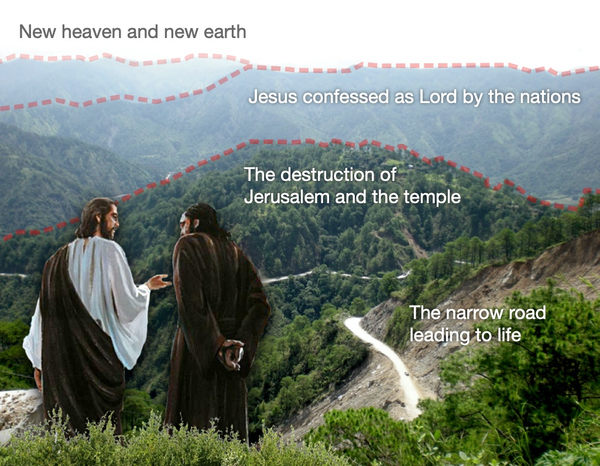
The first horizon is the destruction of Jerusalem and the temple by the Romans in AD 70, which dominates the teaching of Jesus and the preaching of the apostles in Jerusalem after his death. This is the great and awesome day of the Lord from which the inhabitants of Jerusalem would be saved only by calling on the name of the Lord Jesus (Acts 2:14-41).
As the church moved out into the Greek-Roman world, this first horizon did not completely fade from sight, but a more expansive, distant, mountainous horizon beyond was beginning to take shape and solidity in their minds. The apostles became convinced that the good news about Jesus meant not only a radical re-formation of God’s people over the coming decades, but also—sooner or later—the end of the old pagan order and the confession of Jesus as Lord by the nations, to the glory of Israel’s God.
This is Paul’s message to the men of Athens. The true God has long overlooked the centuries of pagan ignorance, but that is soon to change. He has fixed a day in the calendar of history when he will judge the pagan oikoumenē “in righteousness by a man whom he has appointed; and of this he has given assurance to all by raising him from the dead” (Acts 17:31).
It is these immense “political” outcomes that dominate New Testament eschatology, and which, therefore, determine the mission of Jesus, the apostles, and the churches. But on the outer margins of the vision we glimpse a hazy third horizon, a final transformation, a remaking of heaven and earth, when all will be put right. For it was inconceivable to the biblical mind that the creator God would not have the last word.
In the meantime, let’s consider a couple of specific examples from Jesus’ teaching, both having to do with how he talked about the future, to illustrate how this way of reading the New Testament changes our evaluation of the “doctrinal” details.
First, the “second coming”.
I think that the language of a Son of Man coming with the clouds of heaven belongs to the first two horizons, which are dramatic events on the stage of history, not to the third horizon of the renewal of heaven and earth. There is no coming of the Son of Man when the curtain finally comes down on this old creation (Rev. 20:11-21:8).
The motif is drawn from Daniel 7, where it signifies the vindication and “enthronement” of a faithful, persecuted community—or of an individual who embodies that community—when God intervenes in the history of his people, at the climax to a grave political-religious crisis, to put things right.
So when Jesus says to Caiaphas and the leadership of Israel that this generation will see “the Son of Man seated at the right hand of Power, and coming with the clouds of heaven” (Mk. 14:62), he means that when God steps in to judge recalcitrant Israel, some time in the next 30 to 40 years, exactly as he judged rebellious Israel in the past, he will be vindicated and enthroned at God’s right hand.
Secondly, the troublesome doctrine of hell.
Jesus speaks frequently about a “judgment of Gehenna”. It’s not a stray piece of superstition that might be overlooked. It’s a central part of his teaching, and we make best sense of it if we understand it as a detail in the story that is being told about the historical experience of God’s people.
Some Jews at the time were probably beginning to think of Gehenna as a sort of Jewish Tartarus—an infernal place of punishment after death. But Jesus comes speaking the language of Old Testament prophecy. Jeremiah warned the inhabitants of Jerusalem that the city would be besieged by the Babylonians. So great would be the loss of life that there would be no space to bury the dead within the walls; bodies would be thrown into the Valley of the Son of Hinnom to be food for the birds of the air and the beasts of the earth (Jer. 7:32-33; 19:6-7).
The disposal of corpses, therefore, in the Valley of the Son of Hinnom, in Gehenna, was a horrifying prophetic meme for the loss of life that would attend the Roman assault on the city. Gehenna—or “hell’, if we must use the term—was the torment of death and destruction, not torment after death and destruction.
Remarkably, the historian Josephus records just this outcome. During the siege of Jerusalem by the Roman armies, the leaders of the revolt first gave orders that the dead should be buried out of the public treasury. When they could no longer do that, “they had them cast down from the walls into the valleys beneath” (Jos. War 5.12.3). Jesus got it exactly right.
3. How does a narrative-historical approach help us apply the bible to daily life?
Now that’s a tricky one. I’m not sure it does. At least, not in the ways we’ve come to expect. It’s no better than more conventional “hermeneutics” at showing people how to take a passage or verse, more or less at random, and apply it to their daily lives on a Tuesday afternoon, or a Friday evening, or whenever. In some ways it’s worse.
Let’s take as an example Jesus’ much loved saying about the foolish man and the wise man, one building his house on the sand, the other building his house on the rock (Matt. 7:24-27). The narrative historical approach would suggest, I think, that Jesus is talking about a choice facing Israel. Why? Because, as I said, Jesus speaks the language of Old Testament prophecy, and Ezekiel tells a similar story about the false prophets who whitewash the wall that the people have built, and when a deluge of rain comes, the wall is washed away (Ezek. 13:10-16). He is talking, of course, about the Babylonian invasion and the destruction of Jerusalem and the temple.
It makes excellent narrative-historical sense to think that Jesus delivered his own version of this parable as a warning to Israel that if they did not repent, the catastrophe of war and devastation would befall Jerusalem again. But good luck with “applying” that in your sermon on Sunday morning.
That’s the challenge presented by the narrative-historical approach. It makes us come at discipleship and mission—at the practice of being Christian today—from a very different direction.
What it does is this. It helps us to understand how the New Testament works as a raw and largely transparent witness to the historical experience of a renewal movement within first century Judaism.
These Jews believed that God sent his Son to the mismanaged vineyard of Israel to do the work of a servant in seeking the fruit of righteousness.
They believed that God had raised his Son from the dead and seated him at his right hand to judge and rule not only over Israel but also over the nations.
They believed that his death had saved the people of God from obsolescence and opened the door for the inclusion of Gentiles.
They believed that their mission was to live as prophetic communities of these new futures—a people of the one true God that would flourish under a new covenant in the aftermath of the war against Rome, communities of Jews and growing numbers of Gentiles, reconciled in one body, which would signal the coming rule of Israel’s God over the nations of the ancient world.
That’s all history, to be sure. But it’s our history. It tells us who we are, as a people in history, serving the God of history.
We can still find in it the answers to the pressing questions of discipleship and mission. What does it mean to be in covenant relationship with the living God? How do we serve him, speak for him, worship him, trust him, defend his interests, uphold his reputation? How do we do all this under the lordship of Jesus, in the power of the Holy Spirit. What does it mean to belong to a people redeemed by the death of Jesus? How do we live well together?
But I think it also teaches us to ask hard questions about our own place in history—in the West especially, following the collapse of Christendom, faced with the relentless progress of the secular-humanist paradigm, threatened with a mounting ecological crisis for which the coronavirus pandemic may only be a small scale dress rehearsal.
Here is the big practical question.
How do we do what the Old Testament prophets did, what Jesus and the emissaries of his kingdom did? How do we make sense of our place in history? How do we narrate our part of the story?
How do we reimagine our priestly service at the margins of an increasingly foreign culture? How do we work fears of climate catastrophe into our eschatology? How do we give prophetic voice to the conviction that the God who made the heavens and the earth will safeguard the future witness of his people, whatever history has in store for us? What sort of communities do we need to be in order to function well in the age that is coming upon us?
Which brings me to….
4. Andrew, you’ve written a number of books on the Bible. Which is your favourite and why?
The last book is the nearest I’ve got to showing how the narrative-historical approach may bear fruit for ethics and mission. It’s called End of Story? Same-Sex Relationships and the Narratives of Evangelical Mission.
Great summaries, Andrew.
On the ever-thorny issue of application, I think I’ll write my own blog post about this because I’ve certainly been on a long personal journey in terms of how to “apply” the Bible with many different perspectives being contributed to my makeup along the way.
As far as how NH contributes to application, it’s certainly an adjustment, but I don’t think it’s any more or less difficult than the other schemes (except the “what does this passage make me think of?” scheme).
I’d boil it down to a few points:
1. It’s finally ok for a passage to have no direct application.
2. It doesn’t preclude someone’s personal/mystical/devotional encounter with God via reading and meditating on Scriptures. You do have to recognize a difference between what God may be communicating to -you- at that time through that mechanism and “what the Bible means” or “what the Bible says to everyone.”
3. The beginning of how we can apply the Scriptures is very similar if not the same to how we apply history to our lives. We can learn from mistakes. We can see patterns that may warn us or give us hope when we see similar patterns in our present experience. We get insight into the things that always seem important no matter what the historical circumstances of the people of God are, and how they are to go about understanding themselves in their circumstances. For instance, I’m reluctant to use Jeremiah 29:11 as an assurance to a college graduate that they’ll have a great career and family life, but I’m not at all reluctant to use it to encourage a church under an oppressive government whose survival is uncertain. It’s not a promise per se, but it shows us that those circumstances do not mean that God has abandoned them to their fate.
4. This approach should not stifle our ability to use the Scriptures to understand our present circumstances but, instead, provides a measure of freedom. Certainly the NT authors did not think there had to be a direct equivalence between their circumstances and the OT circumstances to use an OT passage to explain what was going on. Their usage was -dependent- on the meaning of the OT passage but not -constrained- by the particulars. While it’s possible to totally go off the rails, here (and certainly some NT usage of the OT kind of looks like that), this is why we have a Spirit-filled community.
@Phil L.:
Thanks for this, Phil. Some good thoughts. Let us know if you write anything further.
@Andrew Perriman:
I started:
https://nextcreation.wordpress.com/2020/05/02/applying-the-bible-part-1-why-its-important/
I would have liked to have done it all in one go, but I could tell it was going to get absurdly long, so I’m going to do it as a series.
@Phil L.:
Thanks for the link. A very good read. Excellent reflections on Psalm 42.
Somewhat by the by, I was struck by the suggestion that the disciples carried swords because Jesus wanted them to look like a bunch of criminals or even rebels. That’s worth thinking about.
@Andrew Perriman:
Thanks! I have a fourth entry in the series but haven’t made the time to write it, yet. Probably this weekend.
The swords to become criminals is a bit of speculation for sure. But the text does present us with the idea that these swords are necessary so that Jesus can fulfill the transgressors Scripture in some way. The text says that’s specifically why he wants them to carry swords. So, in terms of modern application, I think the point stands, but whether or not that was specifically how Jesus (or the author) envisioned Jesus fulfilling that Scripture — I’m guessing, but I think it makes sense.
Thanks, Andrew. The recent posts have been especially helpful in terms of “what does it mean now?” — not in terms of definitive answers, but in terms of hope that tentative answers might be discoverable.
I’m curious what this might mean for the future of “unity” among the groups that self-describe as “churches of Jesus-followers.” If part of the Church’s task in the present age is to tell its story in the light of the past Story — that sounds quite a bit, to my ears, like the formation of provisional “new scriptures” — the “old scriptures” of the agreed (, more or less,) Canon being in at least some instances examples of past interpretive story formulation.
Given the difficulty of imagining that the vast diversity of present groups of self-described “churches of Jesus-followers” are going to agree on how to tell a common story that interprets their recent history and envisages their future, doesn’t it seem likely that the groups are guaranteed to drift further and further apart? One virtue of the old “timeless abstract theology” approach was that it wouldn’t change (much) with the passage of time. Given that these interpretive stories can end up functioning a bit like the original Scriptures functioned in their original settings, it seems to me that one could envision a future of greater and greater schism and rhetorical conflict. That’s not a happy story to tell about oneself.
@Samuel Conner:
I try not to think about it too much.
Andrew, is there an American publisher that prints Re:Mission?
@Scott:
Sadly not.
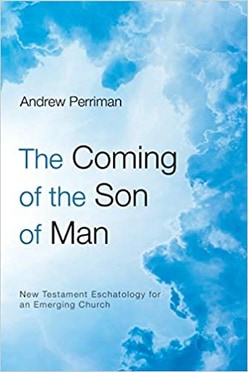
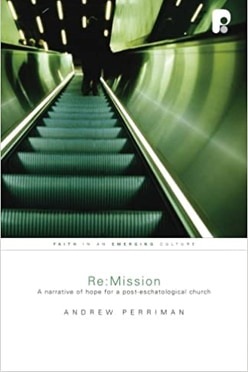
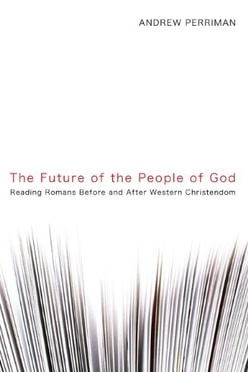
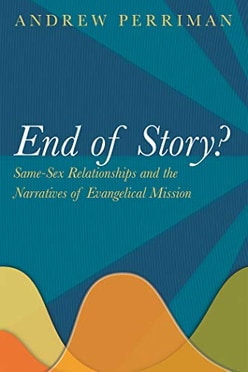
Recent comments